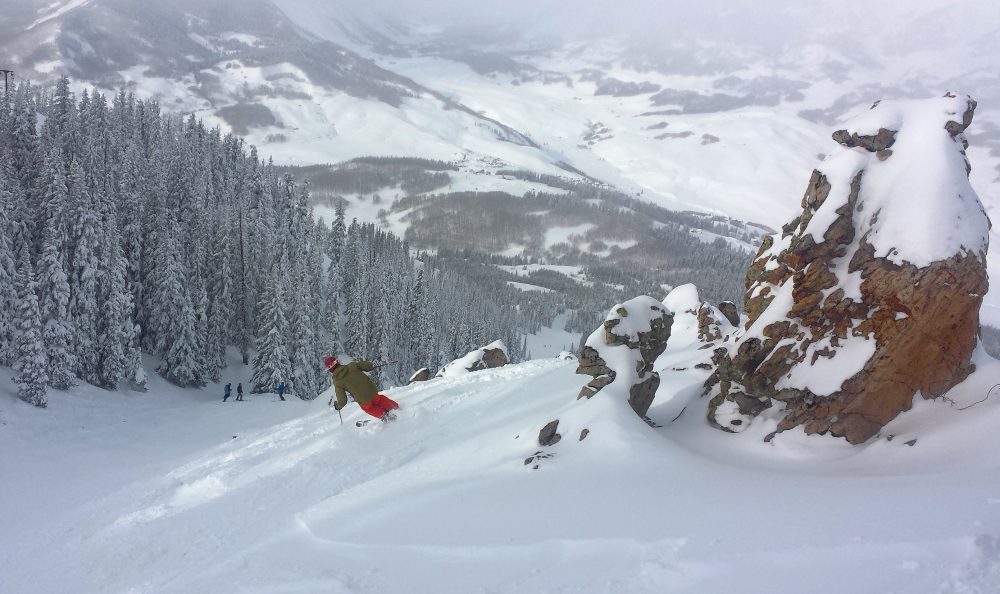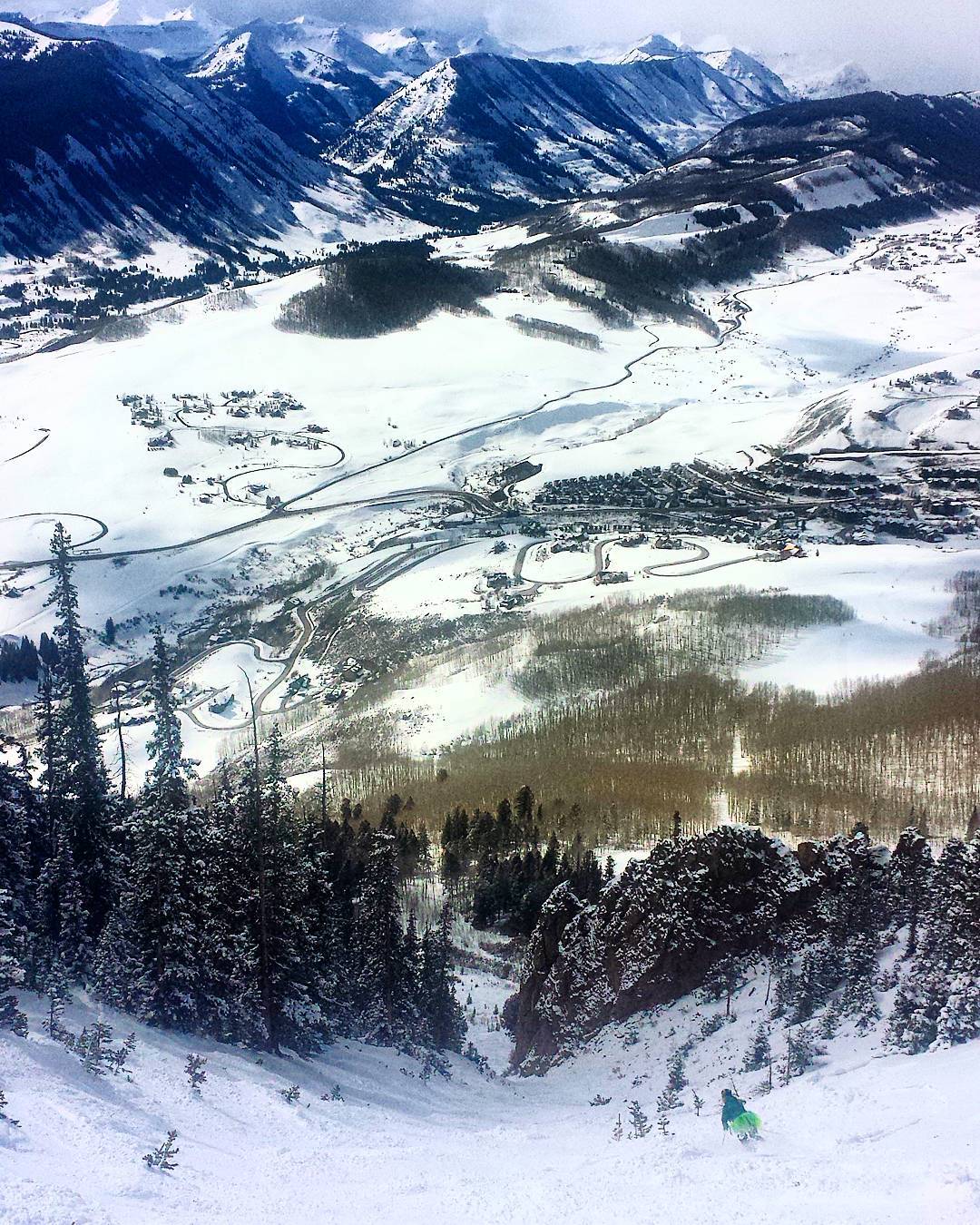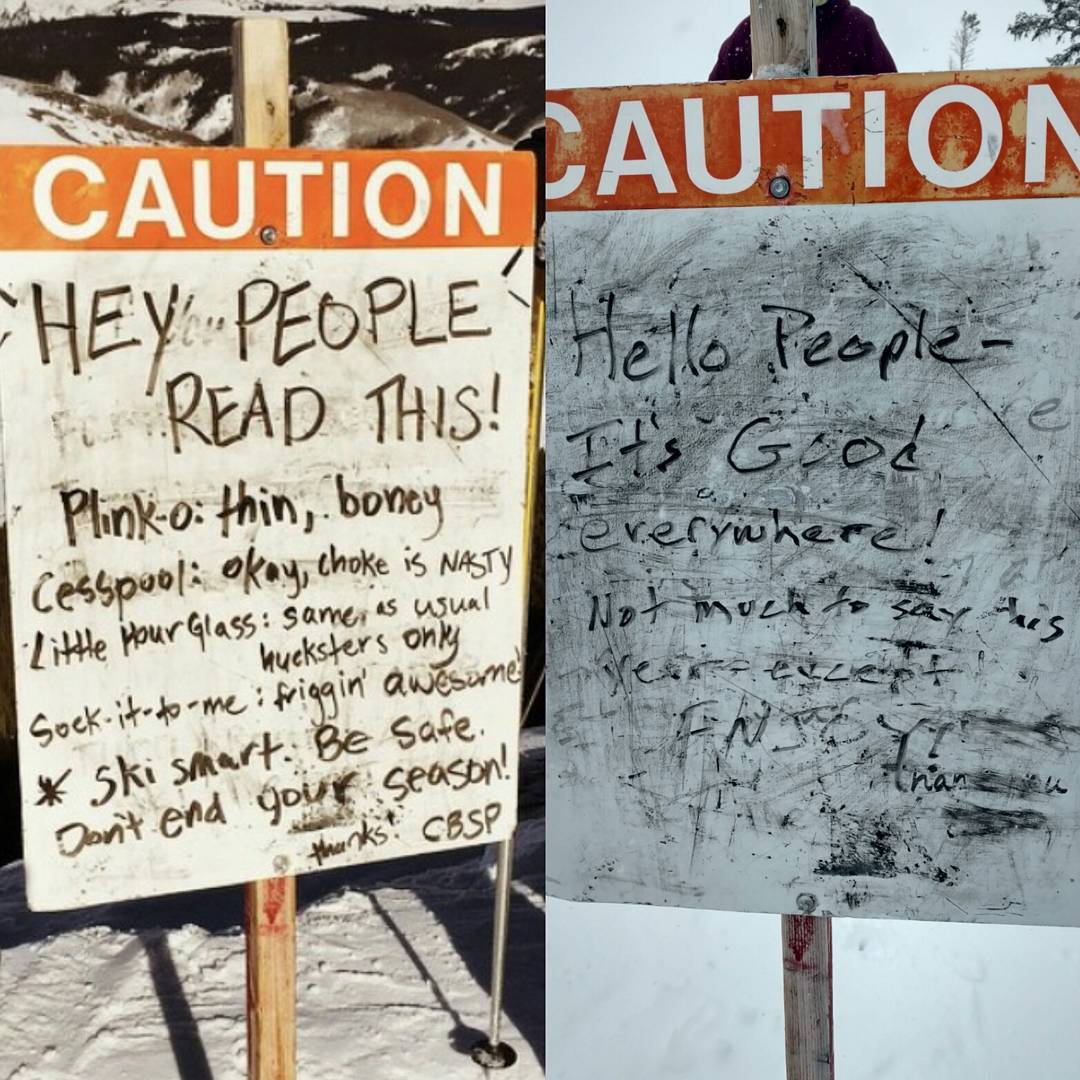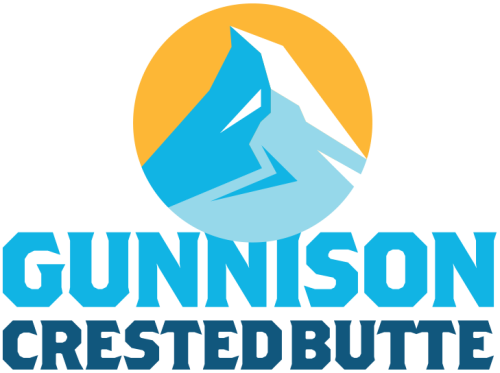First-Timer’s Guide to Crested Butte: The Mountain, Part 3
As people who were once first-timers to Crested Butte in the winter, we know how overwhelming it can be to plan a trip somewhere new. There is a lot of information to take in and lots of decisions to make. So Laurel and I have teamed up to create a 4-part guide to planning a winter trip to Crested Butte.
Note that this guide is not for first-time skiers and snowboarders. It’s designed for advanced and expert skiers and snowboarders who have never taken a winter trip to Crested Butte. That’s who we were thinking of when we wrote about the trails and terrain on the mountain. The stuff related to where to stay and the scene should be useful for everyone though!
This part 3 (part 2 in our terrain descriptions) is all about our favorite lines in “The Extremes” that are accessed from the North Face and High Lifts. Part 1 was an overview of where to stay and part 2 was a guide to early-season steep terrain. We’ll be releasing the final part 4 on The Scene in the next few weeks so stay tuned.
No other mountain in the Lower 48 has the amount of “Extreme Limits” terrain that Crested Butte Mountain Resort has. Almost 1/3rd of our total terrain is double-black and accessed via T-bar drag lifts and hiking. It is some of the most rewarding, terrifying (in some places), and steep skiing/riding that you’ll be able to find inbounds at any ski resort.
A note of caution is included in the writing of this guide. Ski patrol at Crested Butte does a fantastic job of opening terrain. As soon as there is enough snow to pick your way through and the avalanche problem is mitigated it will be open. That being said, Crested Butte is a very rocky mountain and it is likely that you will find some rocks and stumps in the mix. Our mountain is known for having billy-goat lines. Locals ski at a level that is above and beyond the average skier’s ability and have a greater level of comfort with risk, no-fall zones, and hitting rocks with their skis. Don’t follow singular tracks into areas that you aren’t familiar with, and when skiing untracked powder, you need to be in the mindset that there are hidden obstacles.
Do not attempt to ski these lines if you:
- Cannot execute a jump turn;
- Cannot straightline when necessary;
- Are not comfortable with mandatory airs and/or unavoidable cliffs (unless we specifically say the lines don’t have cliffs); and
- Don’t know exactly where you are going.
If you want more information than this guide can give you, Crested Butte Mountain Resort offers a North Face Guides program as part of their ski and ride school.
Rope Drop and Beacon Policy
When ski patrol opens new terrain for the season, or after avalanche control work in the Extremes there is often a beacon policy in effect. The first 50 people into a terrain opening must have an avalanche beacon on and are recommended to carry a shovel and probe with them.
Daniel’s Favorite Lines
I’ve lived in Crested Butte for three winters now and still have a lot of exploring to do before I truly feel like I’ve skied all The Extremes. I am not one for mandatory airs, but I do like the option to jump off things when the snow is deep and I’m feeling rowdy. My motto for skiing is “It’s all about the flow, not the fear.”
Teocalli Bowl
I almost always start my day with a run through Teocalli Bowl. This zone is full of fun, and sees less traffic than other runs off the High Lift. My preferred line is to hike right at the top until I get to the little bench above Duey’s. From there I’ll drop into the trees and chutes just to the skier’s right of Main Street until I reach the flat area in the middle of the bowl. From the flat area I traverse far right again until I get to the ridge in between Wolf’s Lair and Liar’s Bench. This ridge is often untracked and popping turns up and over on both sides is a ton of fun.

Another fun line through Teo Bowl is Morning Glory to Teo Tongue. If you can catch the rope drop, no other place on the mountain gives you the opportunity to practice little rock drops and pillows in a low stress setting than Teo Tongue. Both of these routes that I’ve described will force you to hike out 5-15 minutes depending on fitness and acclimatization. This is something that I’ve always enjoyed as part of my warm up for the day, but other people hate it and avoid it at all costs.
Headwall Glades

I don’t always ski Headwall, but when I do it’s usually not anywhere close to the main area.
My preferred line is to ski
Headwall Glades, a steep section of trees and chutes between Big Chute and Powder 8 Gully. Pretty much everything in here is fun. The real joy is when you find that perfect chute after ducking through a few steep, tight trees. The bottom drops out, you spot your turns all the way to the bottom, and then you just let it rip.
To get to Headwall Glades the ideal line is down through the Halfpipe Gully. Just before you reach “The Easiest Way Down” (this is an actual sign) traverse to Powder 8 Gully. I like to drop off the ridge straight into the trees. From here I often find myself riding the fall line down, but occasionally I’ll traverse left or right for a bit to scope out a new line or seek out a favorite powder stash.
The Peak

I’m all about hiking, and that’s part of the reason that my next favorite line is The Peak. Nothing beats a warm spring day around lunch, taking the High Lift up with a snack in my pocket, and hiking the 20 minutes up to the top of the ski area. While the skiing often isn’t much to write home about (this is one of the easier double-blacks on the mountain), the atmosphere at the top is always a treat. Hiking all the way up yields views as far away as Uncompahgre Peak near Lake City, and the Maroon Bells near Aspen. People love to congregate, throw parties, and cheer each other on as each group drops in either through an easy entrance, or hucks themselves off the cornice crown along the ridge. To really make this run worth it I like to take the High Traverse and ski all the way out to Funnel or Banana to reach the bottom.
Funnel

Speaking of Funnel, this is one of the coolest lines I’ve ever seen or skied anywhere, much less inbounds at a resort. It’s an adventure, it’s steep, and the traverse is committing. Think of the traverse as a good entrance exam. If you’re nervous and have trouble making it to Flatiron then you should consider dropping down early because the final move into Funnel can be much harder, especially in the Spring when the rocks start to poke out. The main draw of skiing Funnel is the Deep Throat area where the run chokes down to about 20 feet and a huge 100 foot fin of rock soars above you. Playing around in this zone can be rewarding and Sunset Ridge, just past Funnel, is a local’s favorite spot to hang out at the end of the day before patrol comes by to sweep.
Phoenix Bowl/Staircase
Last, but certainly not least in my top five favorite lines is Million Dollar Highway to Phoenix Steps to Dead Bob’s and Staircase. If this sounds complicated and convoluted, don’t worry, it’s not, and I’ll break it down for you.
The first thing you want to do is get on the North Face Lift. At the top ski down Avery to the High Notch Entrance and traverse all the way skiers right until you’re at the top of Hawksnest. Traverse right again on the Million Dollar Highway until you’re in Spellbound and Phoenix. Head all the way out to the middle of the bowl and have yourself some fun. Jump off a rock, ski in the trees, and above all keep your eyes out for the traverse back left into Staircase.

A word of caution is appropriate here. This traverse can be scary and tough. There are more trees than the Funnel traverse, and every now and then you’ll come around a corner and a mogul will appear with a sheer backside. Don’t lose hope, and don’t bail early. Staircase is a good place to know where you are going if you can’t see the bottom of a run.
Fortunately, the first place you can see the bottom is a chute called Dead Bob’s. Don’t let the name fool you, it’s one of the easier lines down in this zone even if it is pretty steep. Traversing a little further will put you onto Staircase proper. This line is a little more open, but there’s some fun rocks to jump off of as you pick your way down.
These are the two lines you want (unless you know you don’t want them). Everything else in this zone will require you to put an amount of air between your skis and the snow that most normal people don’t feel comfortable with.
Laurel’s Favorite Lines
Laurel here, taking over for Daniel to share MY favorite lines in the Extremes. I’ll start by telling you a little bit about my skiing. I first learned to ski in Vermont at the age of 4, then grew up skiing the Cazenovia Ski Club (home to the gnarliest terrain in Central New York, a dubious distinction). My parents signed me up for the Race Team for two years and I learned pretty strong technique from two brothers who had raced for the US Ski Team. That technique carried me through college where I was on the Ski Patrol.
Then I moved out west and cut my teeth at Alta trying to keep up with my husband, Tom. We moved to Crested Butte in 2008 and I have been trying to keep up with him and our friends ever since. Luckily our crew doesn’t subscribe to the “no friends on a pow day” philosophy and they have done a wonderful job of coaxing and cajoling me into bigger, higher consequence lines as I am ready for them. I like to ski steep, open lines. I’m not opposed to hitting small cliffs from time to time. I also have vertigo and a fear of heights. I’ll list my five favorites in what I think is easiest to hardest. Depending on your own skiing style, you may disagree with me.
Powder 8 Gully
My first favorite is Powder 8 Gully. It has an apt name and is one of my favorite lines on the entire mountain. Tom doesn’t believe in “warm-up runs” so Powder 8 is often where I start my morning on ski days. This steep, narrow chute runs down skier’s left of the main Headwall off of the High Lift. It’s separated from the rest of the Main Headwall by an obvious ridge.
Powder 8 earns its name because it is such a narrow gully. It requires making pretty tight turns like a classic Powder 8 skier. The shape of the terrain also means lots of snow sloughs into the middle from people skiing up onto the sides of the gully. The high entrance can often be rocky, so you should be comfortable making tight turns, jump turns, and straightlining before you venture into this zone. However, it is free of mandatory air, so it qualifies as an “easier” extreme run in Crested Butte. It’s steep enough that if you fall, you may fall all the way to the bottom, so take it slowly and ski carefully.
The easiest and least rocky way to access Powder 8 is by taking the Headwall Halfpipe all the way to the traverse to the main Headwall. Then traverse through the trees to your right until you hit Powder 8 Gully as you come out of the trees. Look up before you tip in as many people like to access Powder 8 from higher up on the Headwall and you don’t want to cut them off. Enjoy the faceshots on the way down. You’ll often find great snow (chalky, powdery goodness) days after a storm.
Phoenix Chute
Phoenix Chute, like most of the lines on this list, scared the crap out of me the first time I got into it. It hugs the rope line between Phoenix Bowl proper and the permanent closure known as “Big Hourglass.” It’s steep, tree-filled, and has the occasional cliffy element. In other words, don’t go there if you can’t do a jump turn.
The first time Tom took me to the top of Phoenix Chute, I felt my stomach drop to my heels (vertigo!) and I told him to get out of my way immediately because the longer I stood there, the more scared I got. He tipped in and I followed as quickly as I could. I’m one of those people who gets scared standing on top of things, but feels completely competent and comfortable in motion. When I met back up with him at the bottom, he told me I skied it like Ingrid. That was most definitely an exaggeration, but from that moment, I have loved Phoenix Chute.
Rambo
Rambo is next on my list. It has the distinction of being the steepest cut run in North America. It’s not the steepest pitch at CB. That honor probably belongs to Dead End, something in High Life, or “The Edge.” It is, however, the steepest spot on our mountain that a ski area exec said “let’s put a run here” and cut down the trees to make it an open (and now grown back in) run for skiing.
I avoided Rambo for years. A good friend got bucked and hit a tree in Rambo and broke his femur in December 2010. Plus, my insides get mashed up in knots when I stand on top and peer over the edge. It is steep enough that it looks like you can spit off the top and have it hit the bottom unhindered.
To ski Rambo, I learned to ski past it, duck into the trees, and then traverse from the skier’s left below the rollover. It’s still steep, but somehow it’s less scary. Then it’s just big, giant, steep turns. I LOVE Rambo on a pow day, when we call it Rainbow because it’s so good. The pow slows you down and it’s less aggro and more about just feeling the love that open steep pow brings. I first skied Rambo in 2014 on a huge pow day and the photo is me celebrating at the bottom.
Funnel (Again)

Next, we have Funnel. It’s on Daniel’s list, too, but I have to include it. It’s one of those lines that I don’t ski that often. I probably ski it less than any of the other lines on this list. As a line itself, it’s probably the second easiest line. It’s steep and has some narrow parts, but skiing the Funnel doesn’t require the same precision that most of my top lines do.
What Funnel does have, though, is difficult access. To get to the Funnel, you have to traverse really far on a traverse that has some pretty sketchy, committing points and lots of not actually very sketchy points where if you fell for some reason, you’d be in trouble. Those are the kinds of things that get in my head and it’s such a long traverse that I have plenty of time to think about them. An important local’s tip: don’t get off the traverse and try to ski the “pow fields” above and below the traverse. They’re actually rock piles with sucker snow on top of them. You’re going to have a bad day if you go that way.
The reason I do sometimes make the trek all the way to (and from) Funnel is the geology. There is a ridiculously cool rock fin that divides Funnel and Total Recall/Banana that is probably the coolest thing I’ve ever skied next to. I just like to be there, so once in a blue moon, I’ll make the effort to go back there.
Cesspool

Finally, we end with my absolute favorite: Cesspool in the Sock-it-to-me Ridge zone. The first few years we lived in CB, I hated the whole area. There’s a pretty significant compression to get to Sock-it-to-me that is miserable in flat light. There are also a lot of lines that have close-out cliffs so it’s a zone with high consequences. Once I hit a rock on Sock-it-to-me proper, had a binding release, and watched my ski fall down into Little Hourglass. Luckily, a good friend retrieved it for me. After that, I stuck to Last Steep for a while.
The Cesspool choke is how it earned its name. It’s just a nasty bunch of stumps, downed trees, and rocks. It’s about two thirds of the way down the line with a couple of trees in the apron. Most years there is some kind of mandatory air to get through. In 2017, there is an easy way around the choke so far that doesn’t require leaving the ground, but it does require a quick turn around a rock in the skier’s left of the choke. The thing about Cesspool is that that top two-thirds of the line is an absolutely perfect pitch. It’s steep enough that you go fast, but not so steep you can’t make big GS turns. I skied it for the first time on my birthday in 2013 and it has been a favorite ever since.
These are only a few of the best lines in Crested Butte’s Extremes. If you have the skiing or riding ability and the guts, you will not find a better place to shred in a resort in the lower 48. Be safe, ski with buddies, make sure you scope your lines, and have some fun out there!
This terrain may be closed by the ski area management at any time due to adverse conditions. Check with the ski patrol for information. This guide is no substitute for good judgment and expert skiing or snowboarding ability. The Gunnison-Crested Butte Tourism Association and the author(s) of this post accept no liability for any injury, loss, or damage which may arise from use of this guide.
Recent posts
- A guide to the front-side extreme terrain at Crested Butte
- Press release: 2025 Borealis Fat Bike Worlds returns to Crested Butte January 24-26th, 2025
- Natural Selection Tour returns to the Gunnison Valley in 2025
- When should a company form a board of directors?
- A guide to skiing the North Face at Crested Butte
